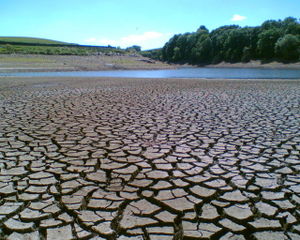Famine

Famine is the scarcity of food over an extended period and over a large geographical area, such as a country. They may be triggered by extreme climate events such as drought or floods, but can also be caused by disease, war, or other factors.[2] Climate change is predicted to change how much water is available for agriculture, which could cause extensive food shortages especially among the poor.[3]
The Food and Agriculture Organization of the United Nations lists several key terms characteristic to famine:[4]
- Malnutrition - An abnormal physiological condition caused by inadequate, unbalanced or excessive consumption of macronutrients and/or micronutrients. Malnutrition includes undernutrition and overnutrition as well as micronutrient deficiencies.
- Hunger/Undernourishment - A state, lasting for at least one year, of inability to acquire enough food, defined as a level of food intake insufficient to meet dietary energy requirements.
- Food insecurity - A situation that exists when people lack secure access to sufficient amounts of safe and nutritious food for normal growth and development and an active and healthy life.
Visit the FAO's website here to see a map of countries in the world that are affected by famine, malnutrition, undernourishment and food insecurity. The map also has extensive statistics for each.
Causes
Two crucial shortages result in famine; the shortage of land to grow food, and the lack of money to buy food.[5] There are many factors that contribute to either of these shortages, such as poor growing conditions or inadequate trade. Places that lack the necessary means to grow or buy food are said to have poor food security. Food insecurity, poor conditions of health and sanitation and inappropriate care and feeding practices are the major causes of poor nutritional status.[4] Areas with high food security, on the other hand, have many alternative plans in order to achieve their food necessities, such as many reliable growers and trade options.[5]
Areas that lack food security are extremely vulnerable when events such as natural disasters or political and economic unrest occur. When these events occur, famine is a potential and worrisome outcome, stemming from the region's inability to attain food at an adequate rate. Such events can cause a phenomena called livelihood shock, which is a disruption so great that the population cannot recover from the immediate consequences.
Areas affected by poverty are especially vulnerable to livelihood shock which in turn creates a positive feedback cycle - a lack of food results in hungry people with a decreased ability to work and better their situation - which in turn locks them into poverty.[5]
Climate change effects on famine
Climate change has many effects on the Earth's cycles, with droughts and floods being two of these. Both of these events can have drastic effects on a region and famine is a potential outcome, especially in the areas with poor food security. Visit the pages on drought and floods to learn more about how climate change and global warming are affecting each of these phenomena.
References
- ↑ Wikimedia Commons [Online], Available: https://upload.wikimedia.org/wikipedia/commons/e/e1/Drought.jpg
- ↑ IPCC, 2012: Glossary of terms. In: Managing the Risks of Extreme Events and Disasters to Advance Climate Change Adaptation [Field, C.B., V. Barros, T.F. Stocker, D. Qin, D.J. Dokken, K.L. Ebi, M.D. Mastrandrea, K.J. Mach, G.-K. Plattner, S.K. Allen, M. Tignor, and P.M. Midgley (eds.)]. A Special Report of Working Groups I and II of the Intergovernmental Panel on Climate Change (IPCC). Cambridge University Press, Cambridge, UK, and New York, NY, USA, pp. 555-564.
- ↑ "Climate change, water and food security" Climate change, water and food security by Hugh Turral FAO consultant Jacob Burke and Jean-Marc Faurès FAO Land and Water Division, available online: http://www.fao.org/3/a-i2096e.pdf accessed December 28th, 2015.
- ↑ 4.0 4.1 FAO. (2015). Glossary of Selected Terms [Online], Available: http://www.fao.org/hunger/glossary/en/
- ↑ 5.0 5.1 5.2 Toothman, Jessika. "How Famine Works" 05 July 2011. HowStuffWorks.com. Available: http://science.howstuffworks.com/environmental/earth/geophysics/famine.htm (Accessed 25 October 2015).

